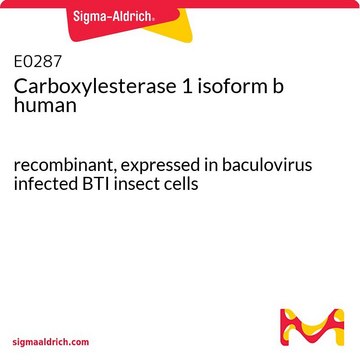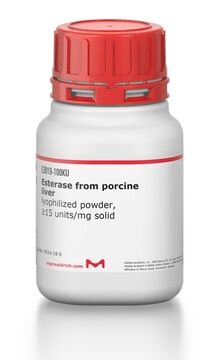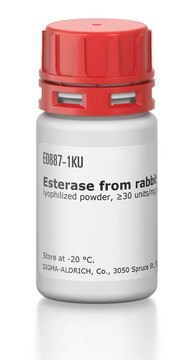C4749
Carboxylesterase 2 human
recombinant, expressed in mouse NSO cells, ≥95% (SDS-PAGE)
Sinónimos:
CES2, CES2A1
Iniciar sesiónpara Ver la Fijación de precios por contrato y de la organización
About This Item
Productos recomendados
recombinant
expressed in mouse NSO cells
Quality Level
assay
≥95% (SDS-PAGE)
form
solution
specific activity
≥1.0 EU/μg
30,000 pmol/min-μg protein
mol wt
predicted mol wt ~60 kDa
concentration
0.4-0.6 mg/mL
impurities
≤1.0 EU/μg endotoxin
shipped in
dry ice
storage temp.
−70°C
Gene Information
human ... CES2(8824)
¿Está buscando productos similares? Visita Guía de comparación de productos
Biochem/physiol Actions
Human carboxylesterase 2 (hCE-2) recognizes a substrate with a large alcohol group and small acyl group. Its substrate specificity may be restricted by a capability of acyl-hCE-2 conjugate formation due to the presence of conformational interference in the active site pocket. Carboxylesterases catalyze the biotransformation of several ester-containing drugs and prodrugs such as angiotensin-converting enzyme inhibitor (temocarpil, cilazapril), anti-tumor drugs (capecitabin) and narcotics.
Member of a serine esterase family that hydrolyze ester and amide bonds. Carboxylesterase 2 is an endoplasmic reticulum-bound hydrolase that plays a critical role in xenobiotic detoxification and activation for ester-containing therapeutics. Carboxylesterase 2 is also involved in the detoxification of drugs such as heroin and cocaine. This enzyme is thought to play a role in lipid metabolism.
Unit Definition
One unit will cause the hydrolysis of 1 picomole of p-nitrophenylacetate per minute at pH 7.5 at 25 deg C.
Physical form
Supplied as a solution containing sodium chloride, sodium acetate, and 20% glycerol.
signalword
Danger
hcodes
pcodes
Hazard Classifications
Resp. Sens. 1
Storage Class
10 - Combustible liquids
wgk_germany
WGK 1
flash_point_f
Not applicable
flash_point_c
Not applicable
Elija entre una de las versiones más recientes:
¿Ya tiene este producto?
Encuentre la documentación para los productos que ha comprado recientemente en la Biblioteca de documentos.
Los clientes también vieron
Teruko Imai
Drug metabolism and pharmacokinetics, 21(3), 173-185 (2006-07-22)
Human carboxylesterase 1 (hCE-1, CES1A1, HU1) and carboxylesterase 2 (hCE-2, hiCE, HU3) are a serine esterase involved in both drug metabolism and activation. Although both hCE-1 and hCE-2 are present in several organs, the hydrolase activity of liver and small
B Sànchez-Nogué et al.
Environmental science and pollution research international, 20(5), 3480-3488 (2012-12-06)
The common sole, Solea solea (Linneus, 1758), and the Senegalese sole, Solea senegalensis (Kaup, 1858), are two important commercial species that coexist in the NW Mediterranean. In order to assess the species' ability to respond to chemical insults, a comparison
Marie C Fortin et al.
Drug metabolism and disposition: the biological fate of chemicals, 41(2), 326-331 (2012-12-12)
Studies on therapeutic drug disposition in humans have shown significant alterations as the result of pregnancy. However, it is not known whether pesticide metabolic capacity changes throughout pregnancy, which could affect exposure of the developing brain. We sought to determine
XieMei Tang et al.
Critical reviews in eukaryotic gene expression, 22(3), 179-187 (2012-11-13)
Tuberculosis remains one of the most prevalent and deadly infectious diseases, largely due to the emergence of multidrug-resistant and extensive drug-resistant Mycobacterium tuberculosis, especially the coinfection with HIV. Mycobacterium Ag85 complex (Ag85A, B, and C), with a carboxylesterase consensus sequence
Zhe-Yi Hu et al.
Analytical and bioanalytical chemistry, 405(5), 1695-1704 (2012-12-15)
Dabigatran etexilate (DABE) is an oral prodrug that is rapidly converted by esterases to dabigatran (DAB), a direct inhibitor of thrombin. To elucidate the esterase-mediated metabolic pathway of DABE, a high-performance liquid chromatography/mass spectrometry based metabolite identification and semi-quantitative estimation
Nuestro equipo de científicos tiene experiencia en todas las áreas de investigación: Ciencias de la vida, Ciencia de los materiales, Síntesis química, Cromatografía, Analítica y muchas otras.
Póngase en contacto con el Servicio técnico












